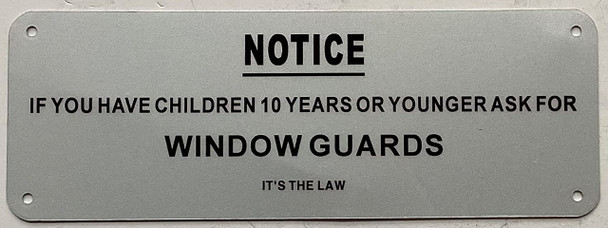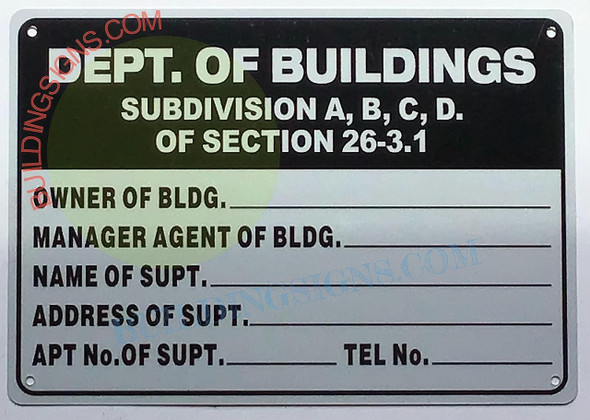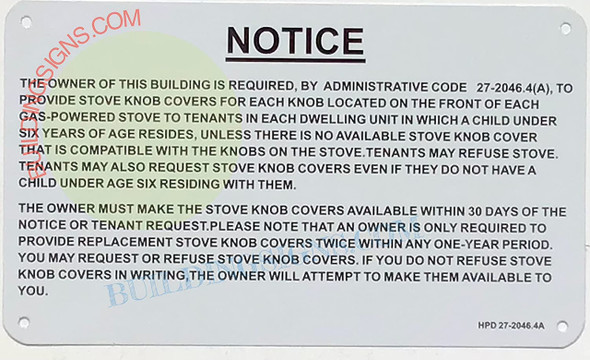Notice: If you have Children 10 Years or Younger Ask for Window Guards Sign -HPD SIGN (WHITE REFLECTIVE. 3X8 INCH,HEAVY DUTY, RUST FREE, ALUMINIUM)
- Availability:
- USUALLY SHIP WITH IN 1-2 BUSINESS DAY
Description
About this item
Notice: If you have Children 10 Years or Younger Ask for Widow Guards Sign
Size:3X8 INCH REFLECTIVE RUST FREE- ALUMINIUM COMMERCIAL USE 4 HOLES- WALL MOUNT DESIGNED TO LAST NYC HPD WINDOW GUARD SIGN
The Importance of Window Guard Signs in Buildings: Ensuring Safety for Young Children in NYC
Introduction
New York City, known for its iconic skyline and densely populated residential buildings, also faces unique safety challenges, particularly for young children living in high-rise apartments. To address these challenges, NYC Local Law 57 mandates the installation of window guards in apartments where children aged 10 and under reside. A crucial aspect of this law is the requirement for buildings to display signs that say, "If you have children 10 years or younger, ask for window guards." These signs play a vital role in safeguarding children and ensuring compliance with local regulations.
Enhancing Awareness Among Residents
Posting signs that inform residents about the availability of window guards significantly enhances awareness. In the hustle and bustle of urban life, crucial safety measures can often be overlooked or forgotten. A prominently displayed sign serves as a constant reminder to parents and caregivers about the importance of window guards. It prompts them to take immediate action to ensure the safety of their children. By making this information readily accessible, the signs ensure that all residents, including new tenants and visitors, are informed about this critical safety feature.
Ensuring Compliance with Local Law 57
Local Law 57 requires landlords to install window guards in apartments where children aged 10 and under live. However, awareness of this regulation is essential for its effective implementation. Signs that explicitly instruct residents to ask for window guards if they have young children ensure that no tenant is unaware of their right to request this safety measure. This transparency helps in holding landlords accountable for complying with the law. By making the requirements of Local Law 57 clear to all residents, these signs play a crucial role in ensuring that window guards are installed where needed, thereby preventing accidental falls and injuries.
Facilitating Communication Between Tenants and Landlords
Effective communication is key to maintaining safety standards in residential buildings. Signs that encourage residents to ask for window guards provide essential contact information, making it easy for tenants to reach out to building management. This facilitates a prompt response to requests for window guards or repairs to existing installations. Clear communication channels ensure that safety concerns are addressed swiftly, reducing the risk of accidents. By providing tenants with direct and actionable information, these signs help maintain a safer living environment for all residents.
Promoting a Culture of Safety and Responsibility
Displaying signs about window guards promotes a culture of safety and responsibility within the building. It signals that the building management prioritizes the well-being of its residents, especially young children. This proactive approach to safety not only protects individual families but also sets a standard for the entire community. When safety measures are clearly communicated and consistently enforced, it fosters an environment where all residents are more likely to engage in and support other safety practices. This collective commitment to safety benefits everyone in the building.
Conclusion
The requirement to display signs instructing residents to ask for window guards if they have children aged 10 or younger is a critical component of NYC Local Law 57. These signs enhance awareness, ensure compliance, facilitate communication, and promote a culture of safety. In a city characterized by its towering residential buildings, the presence of these signs is essential for preventing accidents and protecting the lives of young children. By understanding and embracing the importance of these signs, landlords, tenants, and visitors can work together to create a safer living environment throughout New York City.
DISCLAIMER DISCLAIMER ON LEGAL CODES DISCLAIMER ON SIGN USE GENERAL INFORMATION DISCLAIMER
We are a small, family-owned and family-operated Brooklyn-based business. We are not a City of New York store, nor are our website, products, or services affiliated with the City of New York or any agency of the City of New York. Neither we, nor our business, websites, products, services, or any hyperlinks from our website are sponsored by, approved by, affiliated with, endorsed by, or connected to the City of New York or any agency of the City of New York, including but not limited to HPD, DOB, DOT, DSNY, FDNY, or any federal entity, directly or by implication.
The codes, regulations, and requirements referenced on our website may not represent the most recent or updated versions. State, federal, or local regulatory agencies may have more current or accurate information. We make no warranties or guarantees about the accuracy, completeness, or adequacy of the information provided on this site or linked from it. Customers should verify all information by reviewing the official sources directly.
The requirements for sign content depend on intended use and applicable laws. The buyer is solely responsible for determining the appropriate content for a sign or package of signs. We make no warranty or representation regarding the suitability of any sign for a specific application. It is the customer’s responsibility to ensure that the signs ordered are in compliance with all applicable state, federal, local, and municipal laws. Customers are encouraged to carefully review our Terms and Conditions prior to purchase.
All content on this site is provided for informational purposes only and does not constitute legal advice, professional advice, or a definitive statement of law. For guidance on specific requirements, customers should consult the laws and regulations referenced, as well as any rules applicable in their jurisdiction. You may wish to consult with an attorney or qualified professional to ensure compliance with all applicable legal obligations.



















